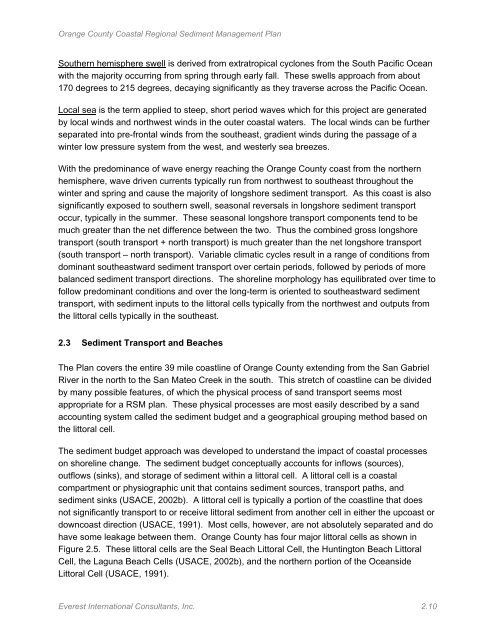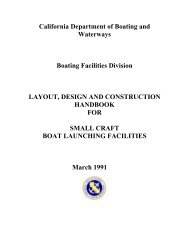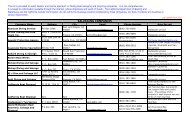EVEREST June, 2013 - California Department of Boating and ...
EVEREST June, 2013 - California Department of Boating and ...
EVEREST June, 2013 - California Department of Boating and ...
Create successful ePaper yourself
Turn your PDF publications into a flip-book with our unique Google optimized e-Paper software.
Orange County Coastal Regional Sediment Management Plan<br />
Southern hemisphere swell is derived from extratropical cyclones from the South Pacific Ocean<br />
with the majority occurring from spring through early fall. These swells approach from about<br />
170 degrees to 215 degrees, decaying significantly as they traverse across the Pacific Ocean.<br />
Local sea is the term applied to steep, short period waves which for this project are generated<br />
by local winds <strong>and</strong> northwest winds in the outer coastal waters. The local winds can be further<br />
separated into pre-frontal winds from the southeast, gradient winds during the passage <strong>of</strong> a<br />
winter low pressure system from the west, <strong>and</strong> westerly sea breezes.<br />
With the predominance <strong>of</strong> wave energy reaching the Orange County coast from the northern<br />
hemisphere, wave driven currents typically run from northwest to southeast throughout the<br />
winter <strong>and</strong> spring <strong>and</strong> cause the majority <strong>of</strong> longshore sediment transport. As this coast is also<br />
significantly exposed to southern swell, seasonal reversals in longshore sediment transport<br />
occur, typically in the summer. These seasonal longshore transport components tend to be<br />
much greater than the net difference between the two. Thus the combined gross longshore<br />
transport (south transport + north transport) is much greater than the net longshore transport<br />
(south transport – north transport). Variable climatic cycles result in a range <strong>of</strong> conditions from<br />
dominant southeastward sediment transport over certain periods, followed by periods <strong>of</strong> more<br />
balanced sediment transport directions. The shoreline morphology has equilibrated over time to<br />
follow predominant conditions <strong>and</strong> over the long-term is oriented to southeastward sediment<br />
transport, with sediment inputs to the littoral cells typically from the northwest <strong>and</strong> outputs from<br />
the littoral cells typically in the southeast.<br />
2.3 Sediment Transport <strong>and</strong> Beaches<br />
The Plan covers the entire 39 mile coastline <strong>of</strong> Orange County extending from the San Gabriel<br />
River in the north to the San Mateo Creek in the south. This stretch <strong>of</strong> coastline can be divided<br />
by many possible features, <strong>of</strong> which the physical process <strong>of</strong> s<strong>and</strong> transport seems most<br />
appropriate for a RSM plan. These physical processes are most easily described by a s<strong>and</strong><br />
accounting system called the sediment budget <strong>and</strong> a geographical grouping method based on<br />
the littoral cell.<br />
The sediment budget approach was developed to underst<strong>and</strong> the impact <strong>of</strong> coastal processes<br />
on shoreline change. The sediment budget conceptually accounts for inflows (sources),<br />
outflows (sinks), <strong>and</strong> storage <strong>of</strong> sediment within a littoral cell. A littoral cell is a coastal<br />
compartment or physiographic unit that contains sediment sources, transport paths, <strong>and</strong><br />
sediment sinks (USACE, 2002b). A littoral cell is typically a portion <strong>of</strong> the coastline that does<br />
not significantly transport to or receive littoral sediment from another cell in either the upcoast or<br />
downcoast direction (USACE, 1991). Most cells, however, are not absolutely separated <strong>and</strong> do<br />
have some leakage between them. Orange County has four major littoral cells as shown in<br />
Figure 2.5. These littoral cells are the Seal Beach Littoral Cell, the Huntington Beach Littoral<br />
Cell, the Laguna Beach Cells (USACE, 2002b), <strong>and</strong> the northern portion <strong>of</strong> the Oceanside<br />
Littoral Cell (USACE, 1991).<br />
Everest International Consultants, Inc. 2.10




